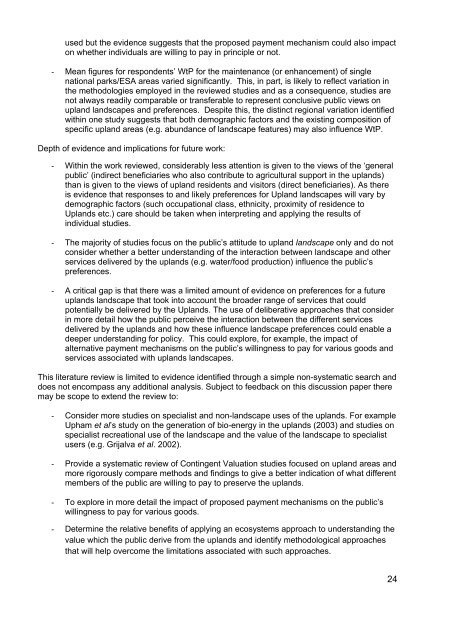Public Attitudes and Preferences for Upland Landscapes - Defra
Public Attitudes and Preferences for Upland Landscapes - Defra
Public Attitudes and Preferences for Upland Landscapes - Defra
Create successful ePaper yourself
Turn your PDF publications into a flip-book with our unique Google optimized e-Paper software.
used but the evidence suggests that the proposed payment mechanism could also impact<br />
on whether individuals are willing to pay in principle or not.<br />
- Mean figures <strong>for</strong> respondents’ WtP <strong>for</strong> the maintenance (or enhancement) of single<br />
national parks/ESA areas varied significantly. This, in part, is likely to reflect variation in<br />
the methodologies employed in the reviewed studies <strong>and</strong> as a consequence, studies are<br />
not always readily comparable or transferable to represent conclusive public views on<br />
upl<strong>and</strong> l<strong>and</strong>scapes <strong>and</strong> preferences. Despite this, the distinct regional variation identified<br />
within one study suggests that both demographic factors <strong>and</strong> the existing composition of<br />
specific upl<strong>and</strong> areas (e.g. abundance of l<strong>and</strong>scape features) may also influence WtP.<br />
Depth of evidence <strong>and</strong> implications <strong>for</strong> future work:<br />
- Within the work reviewed, considerably less attention is given to the views of the ‘general<br />
public’ (indirect beneficiaries who also contribute to agricultural support in the upl<strong>and</strong>s)<br />
than is given to the views of upl<strong>and</strong> residents <strong>and</strong> visitors (direct beneficiaries). As there<br />
is evidence that responses to <strong>and</strong> likely preferences <strong>for</strong> Upl<strong>and</strong> l<strong>and</strong>scapes will vary by<br />
demographic factors (such occupational class, ethnicity, proximity of residence to<br />
Upl<strong>and</strong>s etc.) care should be taken when interpreting <strong>and</strong> applying the results of<br />
individual studies.<br />
- The majority of studies focus on the public’s attitude to upl<strong>and</strong> l<strong>and</strong>scape only <strong>and</strong> do not<br />
consider whether a better underst<strong>and</strong>ing of the interaction between l<strong>and</strong>scape <strong>and</strong> other<br />
services delivered by the upl<strong>and</strong>s (e.g. water/food production) influence the public’s<br />
preferences.<br />
- A critical gap is that there was a limited amount of evidence on preferences <strong>for</strong> a future<br />
upl<strong>and</strong>s l<strong>and</strong>scape that took into account the broader range of services that could<br />
potentially be delivered by the Upl<strong>and</strong>s. The use of deliberative approaches that consider<br />
in more detail how the public perceive the interaction between the different services<br />
delivered by the upl<strong>and</strong>s <strong>and</strong> how these influence l<strong>and</strong>scape preferences could enable a<br />
deeper underst<strong>and</strong>ing <strong>for</strong> policy. This could explore, <strong>for</strong> example, the impact of<br />
alternative payment mechanisms on the public’s willingness to pay <strong>for</strong> various goods <strong>and</strong><br />
services associated with upl<strong>and</strong>s l<strong>and</strong>scapes.<br />
This literature review is limited to evidence identified through a simple non-systematic search <strong>and</strong><br />
does not encompass any additional analysis. Subject to feedback on this discussion paper there<br />
may be scope to extend the review to:<br />
- Consider more studies on specialist <strong>and</strong> non-l<strong>and</strong>scape uses of the upl<strong>and</strong>s. For example<br />
Upham et al’s study on the generation of bio-energy in the upl<strong>and</strong>s (2003) <strong>and</strong> studies on<br />
specialist recreational use of the l<strong>and</strong>scape <strong>and</strong> the value of the l<strong>and</strong>scape to specialist<br />
users (e.g. Grijalva et al. 2002).<br />
- Provide a systematic review of Contingent Valuation studies focused on upl<strong>and</strong> areas <strong>and</strong><br />
more rigorously compare methods <strong>and</strong> findings to give a better indication of what different<br />
members of the public are willing to pay to preserve the upl<strong>and</strong>s.<br />
- To explore in more detail the impact of proposed payment mechanisms on the public’s<br />
willingness to pay <strong>for</strong> various goods.<br />
- Determine the relative benefits of applying an ecosystems approach to underst<strong>and</strong>ing the<br />
value which the public derive from the upl<strong>and</strong>s <strong>and</strong> identify methodological approaches<br />
that will help overcome the limitations associated with such approaches.<br />
24
















